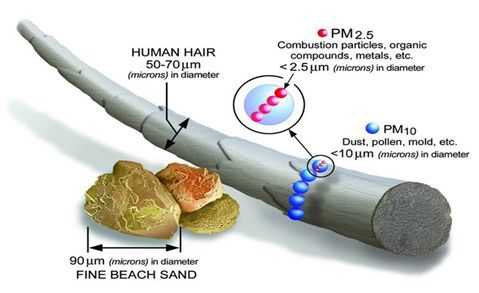Particulate Matter (PM) is the deadliest form of air pollution of all the forms since it can easily penetrate into the lungs and thoracic chambers.
Different Types of Particulate Matter (PM) include:
- SPM – Suspended Particulate Matter
- TRP – Thoracic and Respirable Particles
- PM 10 – Inhalable Coarse Particles
- PM 2.5 – Fine Particles
- Ultrafine Particles
- Soot
What is PM 2.5 Stand for?
PM 2.5 stands for Particulate Matter 2.5. These are minute particles present in the air and penetrate easily into our lungs, thereby causing severe health issues.
PM 2.5 refers to the atmospheric particles with a diameter < 2.5 micrometers, which is about 3% of the diameter of a human hair follicle.
They are extremely small and can only be viewed with the help of an electron microscope.
Whereas PM 10 particles have a diameter of 10 micrometers and are called fine particles.

How much Level of PM 2.5 and PM 10 in the Air is Safe for Breathing?
When the quantity of PM 2.5 in the air is 60 microgram cubic meter and PM 10 is 100 microgram cubic meter, then the air is considered to be safe for breathing.
Different Sources of Particulate Matter
Particulate matter is caused by natural sources such as volcanic dust, sea spray, dust storms, forest fires, etc…
Whereas the human sources of particulate matter include industrial pollution, power plants, vehicular exhausts, tobacco smoke, release of volatile organic compounds into the air from air conditioners, refrigerators etc…
More than the chemical composition, the size of particulate matter is the concern here.
Health Problems Caused by Inhaling PM 2.5 and PM 10
Our cilia and mucus can trap particles greater than 10 microns but the smaller ones like the PM 2.5 can’t be blocked by them.
These particles when inhaled can cause severe health issues, especially
- Respiratory Problems
- Asthma
- Lung Cancer
- Premature Delivery
- Cardiovascular Diseases
- Irritation in eyes, nose and throat
- Low Birth Weight
- Congenital Disabilities
- DNA Mutation (in some instances)
- Heart Diseases
- Early Death (since these particles can penetrate the bloodstream unfiltered)
PM particles can also affect vegetation and interfere with photosynthesis, thereby leading to stunted growth and mortality in plants.
What are the Factors that Affect PM 2.5 Levels?
Wind! Yes, you heard it right! The air can both carry the particles away as well as bring them in.
The air, when there are higher levels of PM 2.5, appears hazy with reduced visibility, just similar to that of a fog or high humidity.
The concentration of PM 2.5 levels increases more during the Winters as the air becomes heavy in that climate.
Similarly, the indoor activities like lighting of oil lamps, candles, insect sprays, aerosol sprays, air conditioners, cooking, etc… can determine the levels of PM 2.5 in the house.
How to Breathe Quality Air for Better Health?
Well, the solution is to install the best-rated air purifier for your home and wear an air purifying mask when going outdoors on two wheeler or use a car air purifier in your 4 wheeler. Additionally, you can also grow these air purifying plants inside your house.

Thanks for the information about the filters.
Thanks for sharing this article.
Thanks for the guide about different Pollutants.